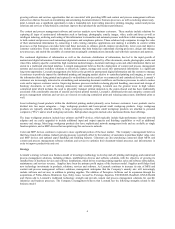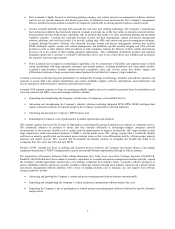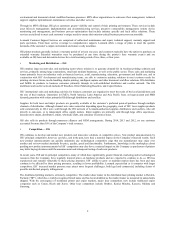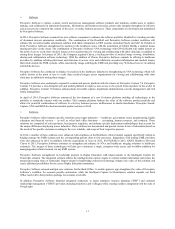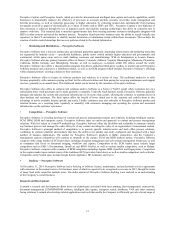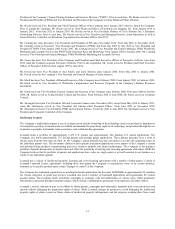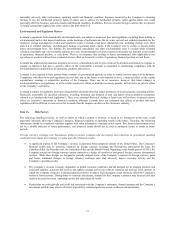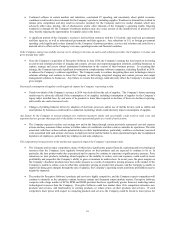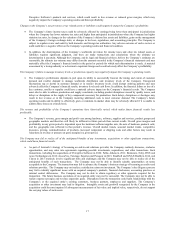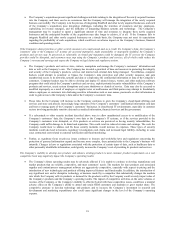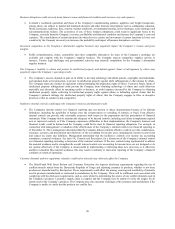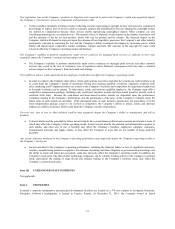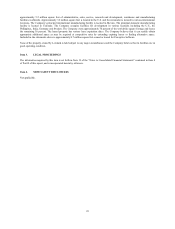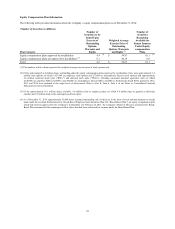Lexmark 2014 Annual Report Download - page 20
Download and view the complete annual report
Please find page 20 of the 2014 Lexmark annual report below. You can navigate through the pages in the report by either clicking on the pages listed below, or by using the keyword search tool below to find specific information within the annual report. Continued softness in certain markets and industries, constrained IT spending, and uncertainty about global economic
conditions could result in lower demand for the Company’s products, including supplies. Weakness in demand has resulted in
intense price competition and may result in excessive inventory for the Company and/or its reseller channel, which may
adversely affect sales, pricing, risk of obsolescence and/or other elements of the Company’s operating results. Ongoing
weakness in demand for the Company’s hardware products may also cause erosion of the installed base of products over
time, thereby reducing the opportunities for supplies sales in the future.
A significant portion of the Company’s revenue is derived from contracts with the U.S federal, state and local governments
and their agencies, as well as international governments and their agencies. Any reductions in U.S. or foreign government
spending could significantly reduce demand for the Company’s hardware products, services and solutions and could have a
material adverse effect on the Company’s revenue, operating income and financial condition.
If the Company cannot successfully execute on its strategy to become an end-to-end solutions provider, the Company’s revenue and
gross margin may suffer.
Since the Company’s acquisition of Perceptive Software in June 2010, the Company’s strategy has been based on becoming
an end-to-end solutions provider of imaging and content, process and output management solutions, enabling businesses to
capture, manage and access critical unstructured information in the context of their business process. In executing that
strategy, the Company has made significant investments in complementary software companies, including ReadSoft in 2014,
to enhance the Company’s solutions capabilities. The Company needs to continue integrating these new technologies into its
solutions offerings and continue to focus the Company on delivering integrated imaging and content, process and output
management solutions to businesses. Any failure to execute this strategy could adversely affect the Company’s revenue and
gross margin.
Decreased consumption of supplies could negatively impact the Company’s operating results.
Nearly two-thirds of the Company’s revenue in 2014 was derived from the sale of supplies. The Company’s future operating
results may be adversely affected if the consumption of its supplies, including consumption of supplies by the Company’s
legacy inkjet installed base, by end users of its products is lower than expected or declines, if there are declines in pricing,
unfavorable mix and/or increased costs.
Changes of printing behavior driven by adoption of electronic processes and/or use of mobile devices such as tablets and
smart phones by businesses could result in a reduction in printing, which could adversely impact consumption of supplies.
Any failure by the Company to execute planned cost reduction measures timely and successfully could result in total costs and
expenses that are greater than expected or the failure to meet operational goals as a result of such actions.
The Company expects to realize cost savings now and in the future through certain previously announced cost and expense
actions and may announce future actions to further reduce its worldwide workforce and/or centralize its operations. The risks
associated with these actions include potential delays in their implementation, particularly workforce reductions; increased
costs associated with such actions; decreases in employee morale and the failure to meet operational targets due to unplanned
departures of employees, particularly key employees and sales employees.
The competitive pricing pressure in the market may negatively impact the Company’s operating results.
The Company and its major competitors, many of which have significantly greater financial, marketing and/or technological
resources than the Company, have regularly lowered prices on their products and are expected to continue to do so. In
particular, the laser printer market has experienced and is expected to continue to experience significant price pressure. Price
reductions on laser products, including related supplies or the inability to reduce costs and expenses, could result in lower
profitability and jeopardize the Company’s ability to grow or maintain its market share. In recent years, the gross margins on
the Company’s hardware products have been under pressure as a result of competitive pricing pressures in the market. If the
Company is unable to reduce costs to offset this competitive pricing or product mix pressure, and the Company is unable to
support declining gross margins through the sale of supplies, the Company’s operating results and future profitability may be
negatively impacted.
The market for Perceptive Software’s products and services is highly competitive, and the Company expects competition will
continue to intensify as the enterprise content, business content and document output markets mature. Perceptive Software
competes with a large number of ECM, BPM and DOM providers that have significantly greater financial, marketing and/or
technological resources than the Company. Perceptive Software could lose market share if its competitors introduce new
products and services, add functionality to existing products, or reduce prices on their products and services. If such
competitors lower prices with respect to competing products and services, the Company could be forced to lower prices for
16


